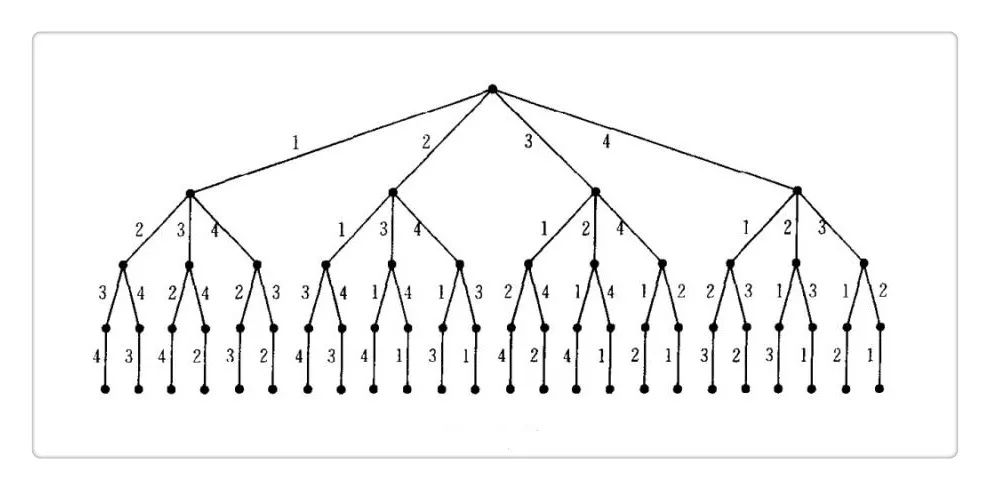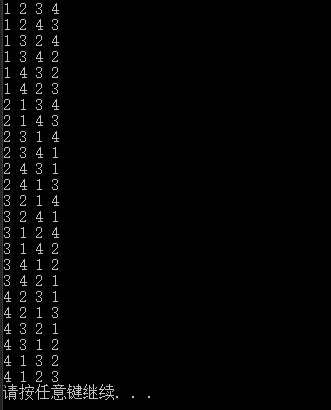Given {1, 2, 3, ,, n}, the full rank is n!, which is the most basic knowledge of high school combinatorics. We use n=4 as an example. All of them are arranged as shown in the following figure (in lexicographic tree format):

It is easy to think of using recursion to find all its permutations.
Observe the above picture carefully.
Start with 1, followed by the full arrangement of {2, 3, 4};
Start with 2, followed by the full arrangement of {1, 3, 4};
Start with 3, followed by the full arrangement of {1, 2, 4};
Start with 4, followed by the full arrangement of {1, 2, 3}.
code show as below:
/**
*
* author : Limer
* date : 2017-05-31
* mode : C++
*/
# include
# include
Using namespace std ;
Void FullPermutation ( int array [], int left , int right )
{
    If ( left == right )
    {
        For ( int i = 0 ; i < 4 ; i ++ )
            Cout << array [ i ] << " " ;
        Cout << endl ;
    }
    Else
    {
        For ( int i = left ; i <= right ; i ++ )
        {
            Swap ( array [ i ], array [ left ]);
            FullPermutation ( array , left + 1 , right );
            Swap ( array [ i ], array [ left ]);
        }
    }
}
Int main ()
{
    Int array [ 4 ] = { 1 , 2 , 3 , 4 };
    FullPermutation ( array , 0 , 3 );
    Return 0 ;
}
Run as follows:

å’¦~ The recursively written full arrangement is not perfect, it does not strictly follow the lexicographic order. However, a friend who is familiar with C++ certainly knows that there is another simpler and more perfect all-arrangement method.
Defined in the file
1, next_permutation, for the current arrangement, if there is a next arrangement in the lexicographic order, return true, and adjust the current arrangement to the next permutation; if not, adjust the current arrangement to be the first in the lexicographic order Arrangement (that is, incremental arrangement) returns false.
2. prev_permutation, for the current arrangement, if there is a previous arrangement in the lexicographic order, return true, and adjust the current arrangement to the previous arrangement; if it does not exist, adjust the current arrangement to the last arrangement in the lexicographic order (that is, descending order), returns false.
/**
*
* author : Limer
* date : 2017-05-31
* mode : C++
*/
# include
# include
Using namespace std ;
Void FullPermutation ( int array [])
{
    Do
    {
        For ( int i = 0 ; i < 4 ; i ++ )
            Cout << array [ i ] << " " ;
        Cout << endl ;
    } while ( next_permutation ( array , array + 4 ));
}
Int main ()
{
    Int array [ 4 ] = { 1 , 2 , 3 , 4 };
    FullPermutation ( array );
    Return 0 ;
}
Run screenshots omitted. The output is exactly in lexicographic order.
What did this "wheel" do? (Extracted from Hou Jie's "STL source code analysis")
1, next_permutation, first, look for two adjacent elements from the end of the end, so that the first element is *i, the second element is *ii, and meet *i <*ii, find a set of adjacent elements Afterwards, check from the end of the tail to find the first element larger than *i. Let it be *j, reverse the i, j elements, and then reverse the arrangement of all elements after ii. "Next" permutations and combinations.
2, prev_permutation, first, look for two adjacent elements from the end of the end, so that the first element is *i, the second element is *ii, and meet *i> * ii, find such a set of adjacent elements Afterwards, check from the end of the tail to find the first element less than *i. Let it be *j, reverse the i, j elements, and then reverse the arrangement of all elements after ii. The "previous" permutations and combinations.
code show as below:
bool next_permutation (int * first, int * last)
{
    If ( first == last ) return false ;   // empty interval
    Int * i = first ;
++ i ;
    If ( i == last ) return false ;   // There is only one element
    i = last ;
-- i ;
    For (;;)
    {
        Int * ii = i ;
-- i ;
        If ( * i < * ii )
        {
            Int * j = last ;
            While ( ! ( * i < *-- j ))   // Look forward from the end until you meet an element larger than *i
                ;
            Swap ( * i , * j );
            Reverse ( ii , last );
            Return true ;
        }
    }
    If ( i == first )   // The current arrangement is the last one in the lexicographic order
    {
        Reverse ( first , last );   // All reversed, ie ascending
        Return false ;
    }
}
bool prev_premutation (int * first, int * last)
{
    If ( first == last ) return false ;   // empty interval
    Int * i = first ;
++ i ;
    If ( i == last ) return false ;   // There is only one element
    i = last ;
-- i ;
    For (;;)
    {
        Int * ii = i ;
-- i ;
        If ( * i > * ii )
        {
            Int * j = last ;
            While ( ! ( * i > *-- j ))   // Look forward from the end until you meet an element larger than *i
                ;
            Swap ( * i , * j );
            Reverse ( ii , last );
            Return true ;
        }
    }
    If ( i == first )   // The current arrangement is the first one in the lexicographic order
    {
        Reverse ( first , last );   // All reversed, descending
        Return false ;
    }
}
Postscript
This article mainly introduces two methods to solve the problem of the total arrangement of non-repeating sequences: recursion and lexicographic ordering .
The RIMA UNL series 2V battery is long life lead acid batteries which have been designed specifically for critical applications that require a longer design life. The battery is based on AGM Battery technology, which means that the electrolyte is absorbed by a fiberglass separator, preventing its leakage, this way the battery can work in any positions.
General Future:
15 years design life(25℃)
Non-spillable construction
Sealed and maintenance-free
High reliability and stability
High purity raw material: long life and low self-discharge
Standards:
Compliance with IEC, BS, JIS and EU standards.
UL, CE Certified
ISO45001,ISO 9001 and ISO 14001 certified production facilities
Application:
Uninterruptible Power Supply (UPS)
Emergency backup power supply
Auto control system
Communication power supply
Alarm and security system
Electric Power System (EPS)
2V Battery,Agm Battery Solar,Long Life Battery,2V Lead Acid Battery
OREMA POWER CO., LTD. , https://www.oremabattery.com